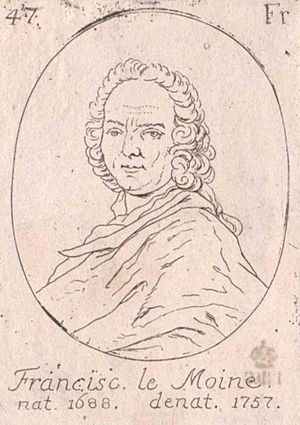François Lemoyne facts for kids
Quick facts for kids
François Lemoyne
|
|
|---|---|
 |
|
| Born | 1688 |
| Died | 4 June 1737 |
| Nationality | French |
| Education | Académie de peinture et de sculpture |
| Known for | Painting |
| Movement | Rococo |
François Lemoyne (born 1688 – died 1737) was an important French painter from the Rococo art period. He won the famous Prix de Rome art prize. He also became a professor at the Académie royale de peinture et de sculpture, which was a top art school in France. Later, he was named Premier peintre du Roi (First Painter to the King) for King Louis XV. Lemoyne also taught art to other famous painters like Charles-Joseph Natoire and François Boucher.
Lemoyne wanted to be seen as the best painter of his time, just like the famous Charles Le Brun before him. His beautiful artworks, especially those at the Palace of Versailles, made people call him the "new Le Brun." He often worked with other artists of his time.
Contents
Biography
Lemoyne was born in Paris, France, in 1688. He started learning art from Louis Galloche until 1713. In 1711, Lemoyne won the Prix de Rome. This prize allowed him to travel to Italy to study art even more.
After returning to Paris, Lemoyne became a full member of the Académie de peinture et de sculpture in 1718. He later became a professor there in 1733. He went back to Italy for a second trip in 1723.
In 1727, a special art competition was held by the duc d'Antin. He was in charge of royal buildings and wanted to encourage historical painting. This competition was a rare chance for artists to show their work to the public. Twelve paintings were entered. Lemoyne and another artist named Jean-François de Troy both won first prize.
In 1728, King Louis XV asked Lemoyne to paint the ceiling of the Salon d’Hercule at the Palace of Versailles. He worked on this huge painting from 1733 to 1736. Lemoyne had seen similar ceiling paintings in Italy. He wanted to show that French artists could paint large, open-sky scenes just as well as Italian artists. When his work was finished, everyone praised it, even famous people like Voltaire. In 1736, his career was at its highest point when he was named Premier peintre du Roi.
Sadly, Lemoyne died on June 4, 1737. He had just finished his big ceiling painting at Versailles. He also completed another painting called Time Saving Truth from Falsehood and Envy for his friend François Berger. Lemoyne was known for being very hardworking and serious about his art.
Style and Influences
When Lemoyne studied in Rome, he learned from the works of old master painters like Raphael and Titian. But his biggest influence was probably Rubens, especially in how he used colors. During his second trip to Italy in 1723, Lemoyne was very impressed by the ceiling of the Palazzo Barberini. He also found inspiration in the works of Venetian painters, especially Paolo Veronese. As his career went on, Lemoyne's style became more influenced by Italian art.
Art experts describe Lemoyne's style as "refined" and "beautiful." His paintings are often said to have a lovely, soft quality.
Major Works
Here are some of François Lemoyne's important paintings:
- Ruth and Booz (1711) – This painting helped him win the Prix de Rome.
- Hercules and Cacus (1718)
- Tancred Surrendering Arms to Clorinda (1722)
- Perseus and Andromeda (1723) – You can see this painting at the Wallace Collection in London.
- Hercules and Omphale (1724) – This painting is at the Louvre Museum in Paris.
- Continence of Scipio (1727) – This was his entry for the 1727 art competition.
- Louis XV donnant la Paix à l'Europe (1727) – Found in the Salon de la Paix at Versailles.
- The Annunciation (1727) – Located at Winchester College.
- Narcissus (1728)
- Venus and Adonis (1729)
- Ceiling of the Salon d'Hercule in Versailles (1736) – This was one of his most famous works.
- Time Saving Truth from Falsehood and Envy (1737) – Also at the Wallace Collection in London.
He also worked on paintings for the Church of Saint-Thomas-d'Aquin and the Abbey of Saint-Germain-des-Prés in Paris.
See also
 In Spanish: François Lemoyne para niños
In Spanish: François Lemoyne para niños

